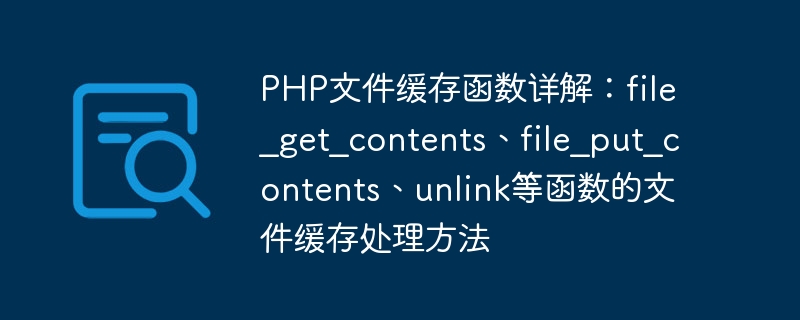

Detailed explanation of PHP file caching functions: file caching processing methods of file_get_contents, file_put_contents, unlink and other functions require specific code examples
In web development, we often need to start from Read data from or write data to a file. Moreover, in some cases, we need to cache the contents of a file to avoid frequent file read and write operations, thus improving performance. In PHP, there are several commonly used functions that can help us implement file caching, including file_get_contents, file_put_contents and unlink functions.
The file_get_contents function is used to read the contents of a file into a string. Its basic usage is as follows:
$fileContents = file_get_contents($filename);
where $filename is the name of the file to be read. When using this function, we can change the default behavior of the function by specifying an optional stream context by passing the second parameter. For example, we can set the cache options of the stream context to cache the file content. The following is a specific example:
// 缓存文件的路径和名称 $cacheFile = '/path/to/cache.txt'; // 判断缓存文件是否存在,并且判断缓存是否过期 if (file_exists($cacheFile) && time() - filemtime($cacheFile) < 3600) { $fileContents = file_get_contents($cacheFile); } else { $fileContents = file_get_contents($filename); file_put_contents($cacheFile, $fileContents); }
In the above example, we first determine whether the cache file exists and determine whether the cache has expired (the judgment here is based on the difference between the modification time of the file and the current time) For this purpose, we set the cache time to 1 hour). If the cache file exists and has not expired, we read the contents of the cache file directly; otherwise, we read the contents from the original file and write the contents to the cache file.
The file_put_contents function is used to write strings into files. Its basic usage is as follows:
file_put_contents($filename, $data);
Among them, $filename is the name of the file to be written, and $data is the data to be written. This function will clear the data in the original file and write the new data to the file.
In the example of caching files, we have used the file_get_contents function when reading the file contents. When writing data to a cache file, we can use the file_put_contents function. The following is a specific example:
// 要写入的缓存文件的路径和名称 $cacheFile = '/path/to/cache.txt'; // 从其他地方获取数据 $data = 'Some data to be cached'; // 将数据写入缓存文件 file_put_contents($cacheFile, $data);
The above example writes $data to the file specified by $cacheFile.
The unlink function is used to delete files. Its basic usage is as follows:
unlink($filename);
Among them, $filename is the name of the file to be deleted. This function deletes the specified file and returns true if the operation is successful; otherwise, returns false.
In some specific cases, we may need to delete cache files. For example, when other data is updated, we may want to delete cache files to keep the data up to date. The following is a specific example:
// 要删除的缓存文件的路径和名称 $cacheFile = '/path/to/cache.txt'; // 删除缓存文件 unlink($cacheFile);
The above example will delete the file specified by $cacheFile.
Summary:
In PHP, we often need to use file operation functions to read and write files. To improve performance, we can use file caching to avoid frequent file read and write operations. The file_get_contents function can read the contents of the file into a string, the file_put_contents function can write the string into the file, and the unlink function can delete the file. By using these functions appropriately, we can achieve effective file caching, thereby improving the performance of web applications.
The above is a detailed introduction to the PHP file caching function and the corresponding code examples. By learning and using these functions, we can better apply file caching to optimize our PHP programs.
The above is the detailed content of Detailed explanation of PHP file caching functions: file caching processing methods of file_get_contents, file_put_contents, unlink and other functions. For more information, please follow other related articles on the PHP Chinese website!




